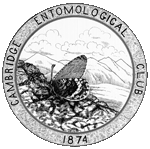
| January 2008: Psyche has a new publisher, Hindawi Publishing, and is accepting submissions |
Article beginning on page 381.
Psyche 3:381, 1880.
Full text (searchable PDF)
Durable link: http://psyche.entclub.org/3/3-381.html
The following unprocessed text is extracted from the PDF file, and is likely to be both incomplete and full of errors. Please consult the PDF file for the complete article.
PSYCHE.
are badly infested with Tetran3chus tviafius upon the adult and young and probably also upon the CAMBRIDGE, MASS., AUGUST 1882. eggs of which this feeds' It may also turn out that two or three species COmAIInfcatimIS, ev<Acasesand BfiitOrs,copiesshould which swarm in pat numbera in the blo~aom8 be afvsseii to BDZTOUS OF PSHNE. cuflt~we, NW. of clover (which are usually full of the eggs Commu,ticatwr.f for pisblication iit Psrca~ awm be and larvae of Cecidorqia hguminicoia.) are par- p ~ p ~ f y {wthe~tticaled. awl an a~tflnsmous ffiHicte.8 will tially 'carnivorou~, and further observations may be pit~iii~u!it.
prove that they mainly search and feed upon the J^flitors and con(ri6tttors are only ~mponstbIe for the sfaiemcnf~ made in their own wmmwiicatwfis. Cecidomyia.
on, subjects ,& r&d to ertf~~logu d l not I may a^o mention here tht this year, SB late be reviewed in PSFCHE.
as 14 November, after several quite twld days, For rates of subscription and of advertisiw, we ad. I found for the first time Bidiothrips huemon-kai-. uerHjUw) cotemna.
ddis, Boucli6, on apple-leaves in the orchard of the IT. 8. Depwrtment of Agriculture, as lively CORRESPONDENCE.
and active fts in hot-housea, where this species HABITS OF TERIPS.
was only observed previously.
h a communication, in Psyche, vol. 8, P. BQ, J Ì £ , al~o mention the presence of Helwt/irip Bfi. Herbert Osborn gives some interesting dracaenae, Heg., in the conservatory of the De- observations on the habits of a certain und& payment Agriculture, an insect which in
scribed species of Phhedhfips which he found in reported as doing immense damage to draeaenaa abundance in all the fruit blossoms which he ex- in ho$houses in different parts of Europe. &mined, stating that they were doing much 2Xdor Pergaade. ' damage to the tender styles by biting and pane- washineton, D, c., 16 xOT, 1883,
taring them and preventing thereby the fertili- -
zation of the ovaries.
BOOK NOTICE.
Taking it for granted that Thips really does It cannot fail to give piensure to naturalists all the damage aseribiid to it, it remains as a to learn that Dr. W. H. Muller, son of Dr. Her- rather singular fact that, notwithstanding the mann Mutler, of Lippstadt, Germany, has begun. great abundance of Thripsia all kinds of flowers, a course of observation and study in a line of the yield of good and numerous seeds it not ma- thought slmihr to that which has made his terially diminished. I am therefore of opin- father's name and works eo well known to stu- ion that, although the TItrip nifty somewhat dents of evolution. injure the styles and other parts of the plants, Dr. W. H. Muller has jiiatpubliehed his disser- they mainly gather the nectar winch is more or tation for obtaining the philosophical doctorate less excreted, and while actively running about at the university of Jena. In the dissertation assist in fertilizing, as more or less of the potten [PSYCHE, Eec., 28911, which is entitled "Proter- will adhere to their feet and body and doubtless andrie der Bienen," the author shows, by careful wili be carried to the stigma.
observations most of which were made without That many species of Thrips are vegetable reference to the ~ubject of which the dissertd? feeders, in some of their stages, has long been tion treats, that proterandry, or the appearance well known, and I have seen numerous species of the males earlier in the season than the fe on all kinds and all parts of plants, and some of muice, exists in all the chief pup8 of lees with these Thrip I have seen in the act of feeding, the exception of the eocinl 'hew.
Dr. Muiler
but I have also observed that not all species proposes to leave the consideration of the more have entirely the same habit, and that some, in complex question of proterandry among social one stage or another, arc corni~orous.
Especi-
bees for special treatment later, but he writes ally have Inoticed this to be the case with a now that he it, convinced that among all bees apeciea which is frequently found upon the the males regularly outstrip the females some- leaves of Piatartus and upon other plants which what in development.
a: D.
================================================================================
Volume 3 table of contents